马上注册,结交更多好友,享用更多功能,让你轻松玩转社区。
您需要 登录 才可以下载或查看,没有账号?立即注册


x
Twenty Years of Micro-Turbojet Engines
微型涡喷二十年
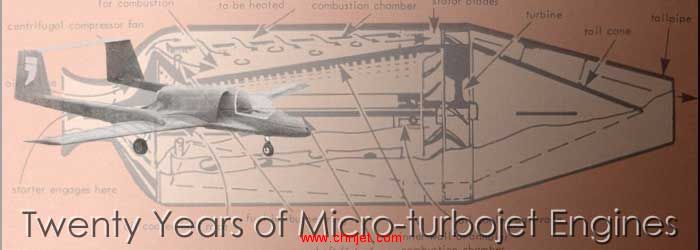
2003 is a year of aviation anniversaries. December of this year marks the 100th anniversary of the first-ever flight of a manned, powered, heavier-than-air aircraft. On the 17th of that month in 1903, Orville Wright piloted the 1903 Flyer on its 120 foot, 12 second flight. That momentous event is being celebrated here in the United States throughout the year in a number of ways, including many recreations of the flight itself with hand-built replicas of the 1903 Flyer. Also, for the first time since 1948, when the Smithsonian Institution in Washington, D.C. acquired it, the original 1903 Flyer will be displayed at eye level for close inspection by museum visitors. Prior to this, it had always hung high near a ceiling. In addition to this signal event, 2003 also marks the 50th anniversary of the formation of the United States Air Force Thunderbirds flight demonstration team.
The beginning of the first flight of a manned, powered aircraft–the 1903 Flyer with Orville Wright at the controls, December 17, 1903.
For those of us in the model aviation community, and particularly those in the model jet world, 2003 marks our own notable event–the 20th anniversary of the first-ever flight of a micro-turbojet powered model aircraft. While this achievement may not rise to the level of distinction of that of the Wright brothers, I think we can agree that it ushered in the birth of an industry that, in two short decades, has seen remarkable technological developments, the launch of many new businesses, and has brought countless hours of enjoyment and fascination to thousands of individuals.
 Beautiful F/A-18 turbojet powered model aircraft spotted at 2003 Florida Jets.
Beautiful F/A-18 turbojet powered model aircraft spotted at 2003 Florida Jets.
If my personal fascination with micro-turbojet engines seems a bit excessive to family and friends, it may be due to the fact that it was only relatively recently that I learned of their existence. Im still in the “I-cant-believe-these-are-real” stage. I recall reading the article in 1983 that announced the success of the UK team, led by Jerry Jackman, in making that first micro-turbojet flight. At the time, Mr. Jackman felt it unlikely that such engines would be available anytime soon on a commercial basis–they would be far too expensive. For a time, he was right. Even then I was fascinated and hung on to that magazine for years until, somewhere along the way, it was lost. The timing of that article also happened to coincide with my leaving the R/C hobby. Little things like marriage, home ownership, children, business travel and night school distracted me a bit. Then, about two years ago I heard of a “jet meet” in my home state of Florida. Yes, I was told, they will be flying true micro-turbojet engines. I had no idea that Mr. Jackmans engine, or one like it, had been commercialized. Of course, I had to check this out, and upon seeing and hearing the genuine article, my fascination was instantly renewed. To this Rip Van Winkle, it seemed as though these marvels of miniature engineering had appeared overnight.
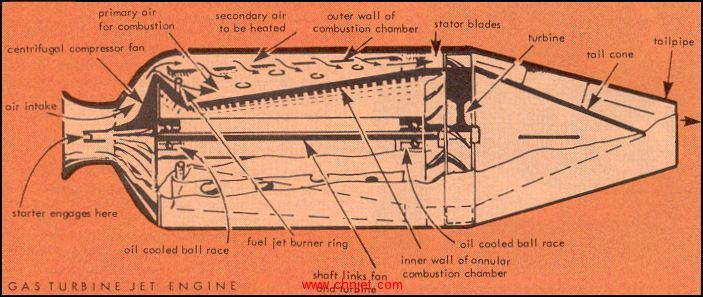 Early design of Jerry Jackman’s micro-turbojet engine.
Early design of Jerry Jackman’s micro-turbojet engine.
If my personal fascination with micro-turbojet engines seems a bit excessive to family and friends, it may be due to the fact that it was only relatively recently that I learned of their existence. Im still in the “I-cant-believe-these-are-real” stage. I recall reading the article in 1983 that announced the success of the UK team, led by Jerry Jackman, in making that first micro-turbojet flight. At the time, Mr. Jackman felt it unlikely that such engines would be available anytime soon on a commercial basis–they would be far too expensive. For a time, he was right. Even then I was fascinated and hung on to that magazine for years until, somewhere along the way, it was lost. The timing of that article also happened to coincide with my leaving the R/C hobby. Little things like marriage, home ownership, children, business travel and night school distracted me a bit. Then, about two years ago I heard of a “jet meet” in my home state of Florida. Yes, I was told, they will be flying true micro-turbojet engines. I had no idea that Mr. Jackmans engine, or one like it, had been commercialized. Of course, I had to check this out, and upon seeing and hearing the genuine article, my fascination was instantly renewed. To this Rip Van Winkle, it seemed as though these marvels of miniature engineering had appeared overnight.
 Barjay, the first radio controlled model aircraft powered by a home-built micro-tubojet engine.
Barjay, the first radio controlled model aircraft powered by a home-built micro-tubojet engine.
The reality, of course, is somewhat different. In 1975, Jerry Jackman built a prototype engine that could run in self-sustaining mode, but could not accelerate. It would take another eight years, and the addition of four people to the effort, to achieve success. Each team member contributed to the project in their area of expertise. Chris White, a machinery engineer, refined the design of the compressor and turbine blades. David Stitch improved the overall rotor design. Ray Carter worked on the overall mechanical design of the engine, and Barry Belcher designed and built the model aircraft, named “Barjay,” that was to be the test bed for the worlds first flying micro-turbojet engine. Finally, on March 20, 1983 the team made model aviation history when, during what were to be taxi trials only, Jackman allowed the aircraft to accelerate to takeoff speed and made the three minute first flight.
 Jackman’s engine itself mounted on “Barjay,” the aircraft test bed.
Jackman’s engine itself mounted on “Barjay,” the aircraft test bed.
Jackman’s engine measured 4¾” in diameter, 13½” long and weighed 3¾ pounds. At 85,000 rpm it produced over 9 pounds of thrust and had a top speed of 97,000 rpm. Twenty years later, commercial engines of roughly similar dimensions and weight are in the 30 pound thrust class when running at 120,000 rpm. The airframe, with its twin-boom high-tail configuration, is remarkably, perhaps inevitably, similar to many of today’s trainer aircraft.
 Jerry Jackman, leaning over Barjay, starts up his micro-turbojet for a test run.
Jerry Jackman, leaning over Barjay, starts up his micro-turbojet for a test run.
It is somewhat fitting that a British team was first in the air with a working micro-turbojet. Forty-six years earlier it was another British team, led by Frank Whittle, that developed and ran the first full-sized turbojet engine. However, it should be noted that the first operational turbojet engine was developed in Germany by Hans von Ohain. His engine powered the Heinkel He 178 in the world’s first jet aircraft flight on August 27, 1939. According to additional historical accounts, the American powers-that-be weren’t all that excited about jet power at the time and, as a result, lagged significantly behind in development. Not so with micro-turbines. An American team, led by Bryan Seegers, was hot on the heels of Jerry Jackman. In fact, this team had their micro-turbojet running reliably in 1981. Had Seegers found a suitable airframe, he may have had his engine in the air in 1982. Still, first is first, and it wasn’t until 1988, five years after Jackman’s flight, that Seegers’ engine took to the air in a radio controlled model aircraft.
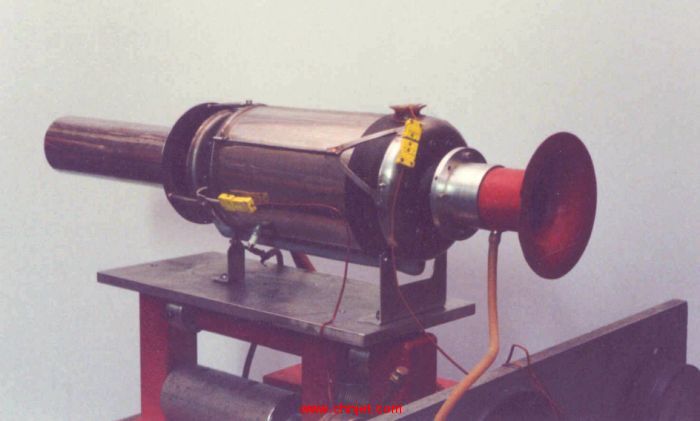 Bryan Seegers’ S-100 micro-turbojet. Three S-100’s were built. This is the third, which powered the first flight a turbojet powered R/C aircraft in the US.
Bryan Seegers’ S-100 micro-turbojet. Three S-100’s were built. This is the third, which powered the first flight a turbojet powered R/C aircraft in the US.
In 1978, Seegers laid out his concept for that first micro-turbojet engine. The one that finally flew in 1988 was little changed from that design. In the interim period, he took three years off from his micro-turbojet project to build a full-size composite aircraft called the “Dragonfly.” He then attempted a redesign of his turbojet engine, only to return to his original concept. Like Jerry Jackman, Seegers’ ultimate success was the result of a team effort. Bob Wahl, an expert in his field, developed the electronic engine control system. Jack Erwin, at one time a NASA aerodynamicist, worked on the diffuser design and Bill Caan, a combustion engineer, designed the burner hole pattern. Jim Allen Jr. designed the aircraft test bed, which was built by Seegers himself. Allen was the only person to ever actually fly the turbine powered model aircraft.
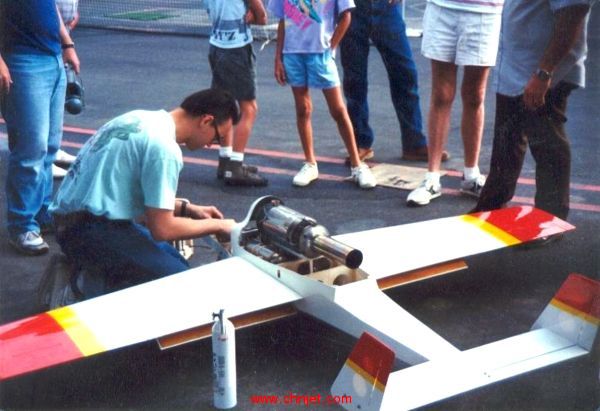 Bryan Seegers works on his engine and aircraft prior to first flight.
Bryan Seegers works on his engine and aircraft prior to first flight.
The challenges facing such a complex project were many, but a few stand out. Seegers had designed and built a number of engines before settling on a final design for the flight article. He wanted the flight version to burn gasoline in lieu of propane. Redesigning the burner to accomplish this proved to be one of the toughest challenges. Another significant challenge was working out the shaft dynamics on the bearing system. In terms of integrating the engine and airframe, the biggest hurdle was the fuel system. Nearly everything from the stainless steel fuel tanks to electronic controls had be designed and built from scratch. He even designed and built a drum brake for the nose wheel. I can only assume that Jerry Jackman and his team faced similar challenges leading up to their success in 1983.
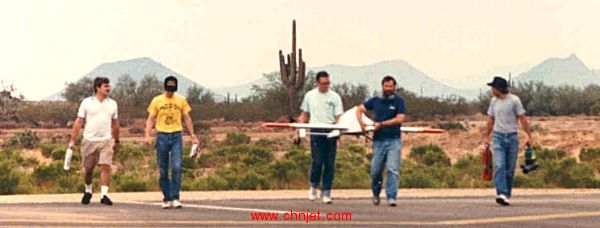 A jubilant team returns with a slightly damaged aircraft after its first flight. The pilot and designer of the aircraft, Jim Allen Jr. in yellow, walks alongside as Bryan Seegers holds the tail of the plane.
A jubilant team returns with a slightly damaged aircraft after its first flight. The pilot and designer of the aircraft, Jim Allen Jr. in yellow, walks alongside as Bryan Seegers holds the tail of the plane.
On July 30, 1988 Bryan Seegers and his team made their own contribution to model aviation history when they became the first in the US to successfully fly a radio controlled model aircraft powered by a micro-turbojet engine. That first flight, however, nearly ended in disaster. Although Seegers was not going to fly the aircraft, he maintained tight control over all aspects of the project. Without his knowledge, someone dialed-in significant down trim on the elevator control. After takeoff, when Allen relaxed up-pressure on the elevator, the aircraft dove into the pavement breaking the landing gear. However, the engine kept running and Allen was able to get the plane back in the air.
Along the way, Seegers experienced another significant event–Hans von Ohain himself visited Bryan’s Arizona home, enjoyed tea in his kitchen and watched his engine run. That visit remains a high point in Bryan’s life.
 Bryan Seegers’ engine and aircraft on display in the Champlin Fighter Museum, Mesa, Arizona.
Bryan Seegers’ engine and aircraft on display in the Champlin Fighter Museum, Mesa, Arizona.
Considering the enormous effort involved in this undertaking, and the time span from concept to flight (8 years or more for Jackman, 10 years for Seegers), I wanted to know what inspired them to keep going. For Seegers the answer was simple and straightforward–he just wanted to hear the incredible sound of a turbojet engine in flight. I think a lot of people can relate to that sentiment. Even now, after years of micro-turbojet powered models being flown at fields around the world, the sound alone turns heads and causes onlookers to drop what they are doing to watch and listen. Today, Bryan Seegers’ engine, and the aircraft it powered, are on display at the Champlin Fighter Museum in Mesa, Arizona. I do not know the disposition of Jerry Jackman’s engine or the test bed, Barjay, but I hope both are still in one piece and might find their own way into a similar display.
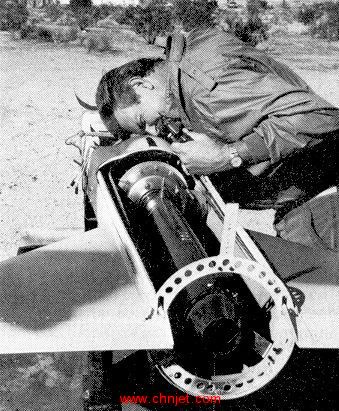 A representative of the engine manufacturer inspects the installation in Continental RPV’s target drone.
A representative of the engine manufacturer inspects the installation in Continental RPV’s target drone.
When it comes to claiming “firsts,” the waters can get a bit murky. We all take for granted the fact that the Wright Brothers were the first in the world to fly a manned, powered aircraft 100 years ago. Yet, until relatively recently, that claim was still being disputed by some. Those disputes do, however, seem to finally be laid to rest. To muddy these waters a bit, just before Seegers’ team made their first flight in the US, there was another project underway utilizing turbojet power in a radio controlled model aircraft. Continental RPV of Barstow, California was attempting to meet a goal of 200 mph with their radio controlled target drones in order to qualify for a military contract. They tried various piston engines and pulse jets, but none were up to the task. They got a break when the military de-classified, under certain restrictions, small turbojet engines then being made to power missiles. Continental RPV was granted permission to use one of these engines in their drones. On the day that Continental broke the 200 mph target with a turbojet-powered target drone, Norm Goyer, then editor of Scale R/C Modeler magazine, was offered the opportunity to fly the beast. With sweating palms and knees knocking, he was handed the transmitter once the 1/5 th scale MiG 27 was in the air. He flew the model aircraft through the speed gates at a nerve-wracking 226 mph! Now, to put this accomplishment in perspective so as not to diminish the achievement of Bryan Seegers a few months later, the engine that Continental RPV used, a Sunstrand TJ-70, was only on loan from the military. Continental couldn’t even buy one, let alone a hobbyist. It was about 6½ inches in diameter and weighed 14 pounds. The drone with engine weighed 95 pounds. There were no provisions for throttle control–the entire flight, from it’s launch off the bed of a pickup traveling at 60 mph to flame-out, was made at full thrust. The drone had no landing gear. Reflecting a familiar sentiment, Goyer wrote of this event, “How do these miniature jets sound? Real Real Real.”
 Norm Goyer with the turbojet powered Continental RPV he flew at 226 mph.
Norm Goyer with the turbojet powered Continental RPV he flew at 226 mph.
For a time, it was fair to say that the micro-turbojets that power model airplanes were not scaled-down versions of the high bypass ratio, multi-spooled turbofan engines that power today’s commercial and military aircraft. Indeed, long before micro-turbojets became available to modelers, there were real-world reasons to develop scaled-down versions of very sophisticated full-size turbojet engines. In the mid-1950’s, Williams International, for example, was started to develop small turbojet engines leading to multi-spooled turbofans intended for use in cruise missiles and other military applications. Unfortunately, such engines were still far too complex, too expensive and, at 150 pounds, too large and heavy for use in model aircraft. If modelers were to have true turbojet engines, they would have to be designed from the bottom up instead of top down.
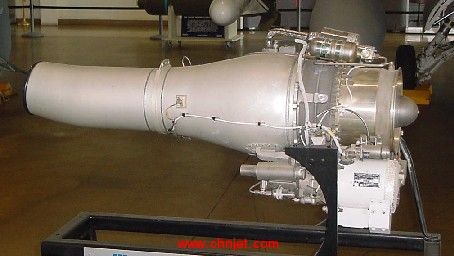 Williams International F107-WR-101 advanced two-shaft turbofan engine built to power the AGM-86B Air-launched Cruise Missile (ALCM). Weight: 146 pounds. Thrust: 600 pounds.
Williams International F107-WR-101 advanced two-shaft turbofan engine built to power the AGM-86B Air-launched Cruise Missile (ALCM). Weight: 146 pounds. Thrust: 600 pounds.
For a time, it was fair to say that the micro-turbojets that power model airplanes were not scaled-down versions of the high bypass ratio, multi-spooled turbofan engines that power today’s commercial and military aircraft. Indeed, long before micro-turbojets became available to modelers, there were real-world reasons to develop scaled-down versions of very sophisticated full-size turbojet engines. In the mid-1950’s, Williams International, for example, was started to develop small turbojet engines leading to multi-spooled turbofans intended for use in cruise missiles and other military applications. Unfortunately, such engines were still far too complex, too expensive and, at 150 pounds, too large and heavy for use in model aircraft. If modelers were to have true turbojet engines, they would have to be designed from the bottom up instead of top down.
Even after the successes of Jackman and Seegers, the average modeler did not have access to micro-turbojets for many years. In the interim period, though, we have gentlemen like Thomas Kamps and Kurt Schreckling to thank for their efforts in developing engines and publishing plans that would allow anyone with access to a relatively well-equipped machine shop to build and fly their own engines. The availability of off-the-shelf centrifugal compressors made the job of building one’s own engine easier, but it was still a demanding exercise. Before complete engines became available, there was one other development that aided the home-builder. With the growing interest in micro-turbojets, at least one company went into production of axial turbine wheels, these being perhaps the most difficult part for the home-builder to fabricate. While these developments opened up the world of micro-turbojets to such fortunate individuals, commercialization and mass production were yet to bring these engines to the general model aviation community.
Today, of course, we have a wonderful mix of not only commercially produced engines, but a continuation of home-built, one-of-a-kind examples that push the envelope of this miniature technology. Indeed, while the commercial manufacturers are doing a great deal to refine and improve micro-turbojet engines, much of the innovation continues to be among home-builders. Recent examples include multi-stage axial compressor designs and twin-spooled turbofan engines.
 Ewald Schuster’s remarkable Pegasus-style turbofan intended to power his VTOL Harrier.
Ewald Schuster’s remarkable Pegasus-style turbofan intended to power his VTOL Harrier.
One of these innovators is Ewald Schuster. He is self-taught in the art and science of turbojet design and fabrication, yet has achieved remarkable results in miniaturization (more on that later) and turbofan fabrication. He is currently working on a Pegasus-style turbofan engine with movable ducting for a scale Harrier. We are rapidly getting to the point where this bottom-up development, as opposed to scaled-down engineering, is leading to engines that do indeed emulate their larger cousins in function and sophistication. The sophistication of these engines, and that of the model aircraft they power, has blurred the lines of distinction between hobby aircraft and military/commercial unmanned aerial vehicles, or UAV’s.
One example of where these worlds collided (“merged” may be a better choice of word) was the “F18 Project” conducted by North Carolina State University in conjunction with the US Navy and Bihrle Applied Research. The micro-turbojet powered aircraft that came out of this program would make any jet modeler’s eyes tear with envy. In the mid-1990’s, this team was tasked with the development and flight test of a 17.5% scale F/A-18E/F Super Hornet. The model itself was 10 feet long with a wingspan of 7.5 feet. It was powered by two micro-turbojets, each producing 40 pounds of thrust. It weighed 140 pounds.
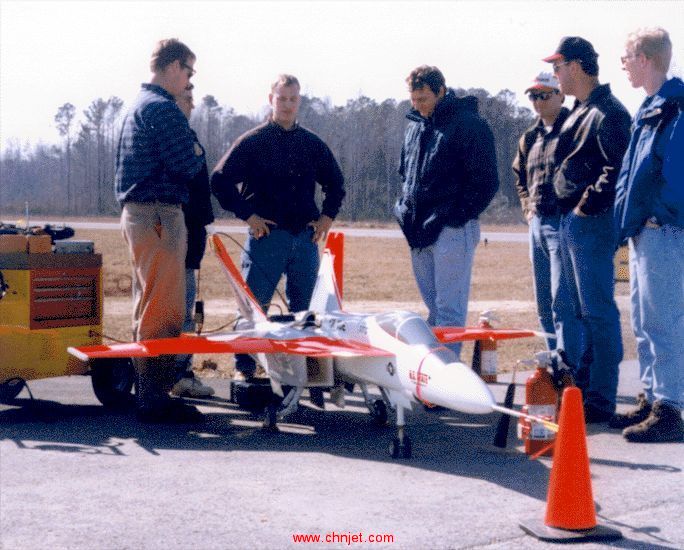 NCSU team prepares 17.5% scale F/A-18E/F Super Hornet for test flight.
NCSU team prepares 17.5% scale F/A-18E/F Super Hornet for test flight.
The purpose of the F18 Project was to support the flight test program of the full-size aircraft and associated flight simulators. The advantages of a test program of this nature are many. First, the total cost of the model effort equaled only a few hours of flying time of the full-sized, manned test aircraft. Second, a flying scale model allows data to be collected on a new airframe without endangering the life of a test pilot. In addition, aerial maneuvers can be performed that are not easily simulated in a wind tunnel with non-flying scale models. During the test program, the model F/A-18 would be flown by a radio control pilot standing next to the runway. After reaching altitude, control would be turned over to a remote cockpit elsewhere on the ground. An on-board video camera relayed images from the model to the remote cockpit. As the remote pilot took the aircraft through a series of preplanned maneuvers, on-board sensors would collect and store data for later analysis. If a flight emergency arose, the radio control pilot could take over flight at any time and, in any case, was handed back control for landing after the test flight was complete.
While some have been working to make micro-turbojets more complex, others have been working to make them smaller. In addition to the turbofan mentioned above, Ewald Schuster has built a tiny turbojet engine that measures a mere 5″ long and 2¼” in diameter. It weighs only 6.5 ounces, yet develops 4 pounds of thrust. This engine has had four successful flights to date. Schuster is currently working on an even smaller engine that will measure 1¼” in diameter, run at 500,000 rpm and produce 1½ pounds of thrust. Smaller still is a mini-micro-turbojet developed by Bryan Seegers’ M-Dot Aerospace under a project funded by the Defense Advanced Research Projects Agency, or DARPA. This little gas turbine can fit inside an egg and develops 1.4 pounds of thrust.
 Ewald Schuster’s 2¼” diameter engine produces 4 pounds of thrust.
Ewald Schuster’s 2¼” diameter engine produces 4 pounds of thrust.
Developing ever smaller turbojets poses significant hurdles that must be overcome if one is to produce a viable engine. Among the most significant are the reduced efficiency that results from downsizing and the increased demands on bearings. The clearance between turbine blade tips and housing must get tighter in order to maintain operating efficiency. In the case of Schuster’s 2¼” diameter engine, the clearance is only 0.0025″, which is less than the thickness of a human hair. Smaller engines run at higher rpm’s, placing huge demands on bearings. Still, these hurdles are being overcome and both Schuster’s and M-Dot’s tiny turbojets have run successfully, with even smaller engines to come.
 M-Dot’s turbine-in-an-egg has produced 1.4 pounds of thrust in bench tests.
M-Dot’s turbine-in-an-egg has produced 1.4 pounds of thrust in bench tests.
Just how small will turbojet engines get? Imagine, if you can, a machine so small that you need a microscope to see its parts; so tiny that the legs of a spider mite can bring its gears to a grinding halt. Borrowing from the techniques used to manufacture semiconductor computer chips, students and engineers at the Gas Turbine Laboratory of the Massachusetts Institute of Technology have developed what amounts to a turbine-on-a-chip. These engines, and other tiny machines made by the same process, are referred to as micro-electromechanical systems, or MEMS. Built-up and etched one layer at a time, just like semiconductors, these MEMS engines have all of the essential components for true turbojet operation. The entire package, including the compressor and turbine rotor assembly, diffusion vanes, turbine nozzle vanes, fuel injectors and combustion chamber is no larger in diameter than a dime. It weighs about 1 gram and is expected to have a thrust to weight ratio of 100 to 1. The best modern jet engine has a thrust to weight ratio of 10 to 1.
 The legs of a spider mite dwarf the gears of this MEMS device.
The legs of a spider mite dwarf the gears of this MEMS device.
To date, each of the components that make up the entire MEMS turbojet has been individually tested, but the package has not yet run as a complete turbojet. The turbine with nozzle guide vanes, measuring 6mm in diameter, has been run at 1.4 million revolutions per minute. The compressor with inlet guide vanes, measuring 8mm in diameter, has been run at 480,000 rpm and has achieved a compression ratio of 4:1. The method of manufacturing these engines is essentially a two dimensional process, limiting the compressor to centrifugal flow and turbine to radial flow. Emerging technologies, however, may lead to three dimensional manufacturing processes which would allow for the design of axial flow components.
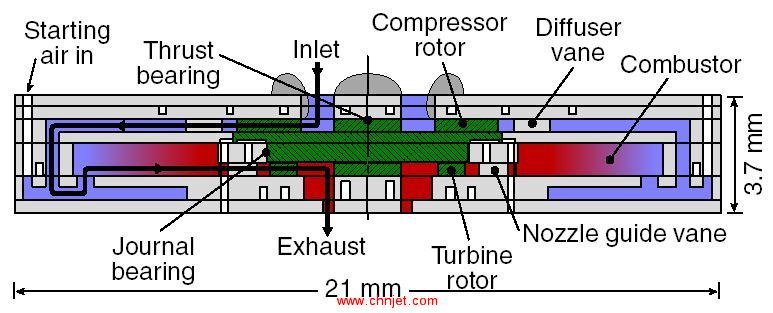 All of the essential components for true turbojet operation are present in this “turbine-on-a-chip.”
All of the essential components for true turbojet operation are present in this “turbine-on-a-chip.”
While the primary application of the MEMS turbojet is electric power generation, these mini-micro-turbojet engines could be used to power micro air vehicles, or MAV’s, which are defined as being no larger than 6 inches in any dimension. MAV’s are being developed to carry out a number of military and some civilian missions including real-time reconnaissance utilizing tiny on-board video cameras, laser marking of targets and even analyzing the air for potential chemical or biological warfare agents. Personally, I can clearly envision one of these ultra-small turbojet engines powering my park flyer.
 Measuring just 4mm in diameter, this MEMS turbine has been spun up to 1.4 million rpm.
Measuring just 4mm in diameter, this MEMS turbine has been spun up to 1.4 million rpm.
While the primary application of the MEMS turbojet is electric power generation, these mini-micro-turbojet engines could be used to power micro air vehicles, or MAV’s, which are defined as being no larger than 6 inches in any dimension. MAV’s are being developed to carry out a number of military and some civilian missions including real-time reconnaissance utilizing tiny on-board video cameras, laser marking of targets and even analyzing the air for potential chemical or biological warfare agents. Personally, I can clearly envision one of these ultra-small turbojet engines powering my park flyer.
 Cutaway of entire MEMS turbojet showing flow channels and compressor disc.
Cutaway of entire MEMS turbojet showing flow channels and compressor disc.
It has been a fascinating 20 years in the world of micro-turbojets since Jerry Jackman made his first flight in 1983. The pace of development seems to only be accelerating. The next 20 years promise to bring even more excitement to the radio control jet modeler.
Barrie, Darwin N. “Turbo Jet.” Radio Control Modeler December 1988: 222-226, 230.
Batt, Gordon. “Jet Flight Triumph.” Radio Control Modeler September 1983: 148-150.
Epstein, Dr. Alan H. (Director, Gas Turbine Laboratory, Massachusetts Institute of Technology.) “Millimeter-scale, MEMS
Gas Turbine Engines.” Paper presented to ASME Turbo Expo 2003. 16-19 June 2003.
Goyer, Norm. “True Turbines are Here to Stay – Flying High and Fast.” Scale R/C Modeler March 1988: 34-39, 74-76.
Goyer, Norm. “True Turbines are Flying in America.” Scale R/C Modeler November 1988: 32-39.
Jacobson, Dr. Stuart. (Deputy Director, MIT Microengine Project, Massachusetts Institute of Technology.) Personal Interview. 14 August 2003.
Schuster, Ewald. Personal Interview. 5 August 2003.
Seegers, Bryan. Personal Interview. 19 March 2003.
Williams, Bob. “NCSU-built model to save Navy big bucks.” The News & Observer January 28, 1997
PS:不知道是不是有人发过?
|
![]()
![]()